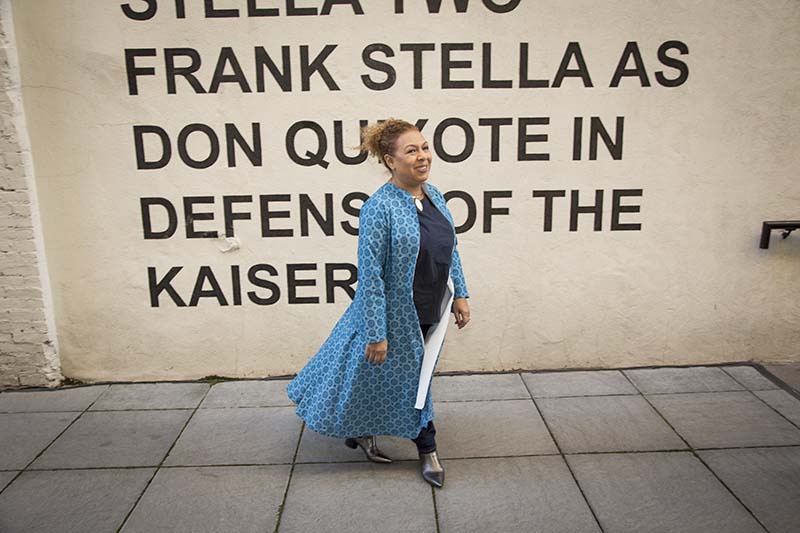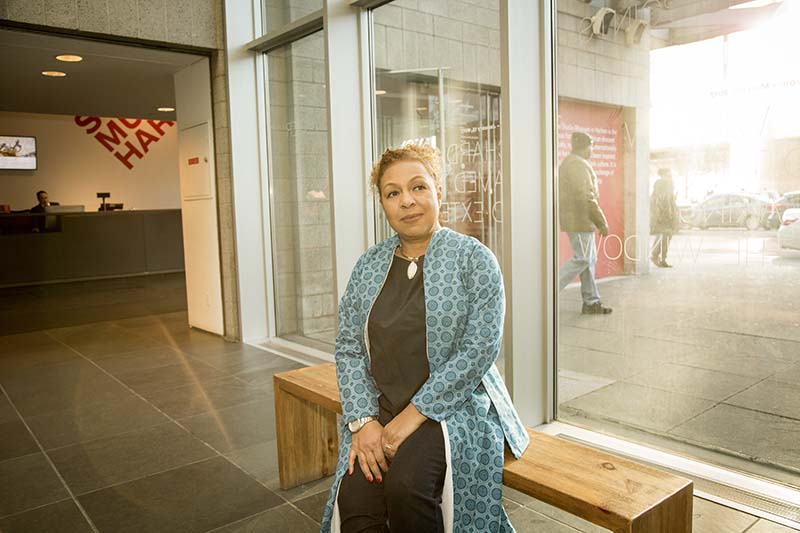In one corner hung a work by Los Angeles artist David Hammons, whom Jones met in 1980 at the Studio Museum. Hammons became a renegade darling of the art world, but he was not yet a household name in 1986, when Jones snagged a lengthy interview with him for REALLIFE Magazine, eliciting an incisive appraisal of his own art, along with some irascible witticisms (“I can’t stand art, actually. I’ve never ever liked art, ever.”). The piece we were looking at, Jones explained, was an example of the “body prints” with which Hammons made his name in the 1960s. She described the technique. “He greases his body up, leans on a piece of paper or board, jumps off, then sprinkles pigment on it, and the pigment stays in the oil-infused areas. In this one, it looks like he’s actually drawn on it as well.” The artist’s face appears in a shadowy field of blacks and grays with pastel overlays traced with a wire-mesh grid that creates a cage-like effect. That and the absence of eyes—just round holes—lend an eerie, haunted look.
“This is fabulous,” Jones said. “His earlier body prints were more didactic. By this time, 1976, he’s getting all free with it. He’s really free.”
Hammons eventually became a found-object artist, trolling city streets for his whimsical compilations. The results include his “bottle trees”—emptied bottles of Wild Irish Rose (“the cheapest wine you can get,” Jones said) slipped over branches in wintertime Harlem. Or Greasy Bags and Barbecue Bones, a gallery show Jones describes as “composed of discarded brown paper bags, sparerib bones, glitter, hair and grease.” For Jones—typically—such works aren’t merely enjoyable but tilt at something larger. “By identifying and repossessing particularly negative, stereotyped, dirty, rejected symbols and signs through reconstituted objects,” she writes in an essay for a recent Hammons retrospective, “the artist retools judgments concerning beauty and, in a sense, refigures aesthetics.”
Hammons’ art resonates deeply with Jones’ sensibility and priorities. Not least is how the artist repurposes everyday objects in ways that convey personal and cultural history. “Picking bottles up off the ground and elevating them was a way of making art,” Jones told me, “but also of saying that people’s lips had touched them, and so they have spirit in them.” She enthuses over how Hammons has reached beyond museum and gallery, citing his wry boast that his outdoor installations are seen by “15 times the annual attendance of the Metropolitan Museum.” Above all she lauds his effort to reclaim the stereotyped and ignored. In praising Hammons’ mission, Jones implicitly describes her own. The artist refigures aesthetics; the art historian reframes traditions.
That challenge has been both intellectual and very personal. For Jones, starting out as an aspiring curator, tradition meant scrutiny at the door; the art world was a white world, and viewed her skeptically. “You’d go for an interview—museum jobs, gallery jobs—and people would look at you as if to say, ‘What are you going to do here?’” African-American museum directors, curators and tenured art historians were few. And over much of the 20th century, African-American artists had been routinely neglected. In 1968, Jones told me, when MoMA mounted an exhibition titled In Honor of Martin Luther King, Jr., it did not actually include any black artists, until protests forced a change.
In those years the art world was taking what Jones calls “wobbly baby steps” toward diversity. Museums, responding to public pressure, began buying works by more artists of color. But there was a token aspect to these acquisitions. “They buy them, they show them once and that’s it,” she explained. “Forty years later they’re sitting in storage at the Met, at MoMA, at the Los Angeles County Museum.”
Part of Jones’ effort has been to direct attention to resources already present. And part has been to expand the range of what gets written about, shown, noticed and taught in the art world—even what gets thought about as art. This expansion has been a steady focus of her writings, beginning in the 1980s—from her exploration of Hammons’ works incorporating African-American hair, to her assessment of Howardena Pindell’s use of string, glitter and perfume in paintings addressing racism and sexism.
Jones’ interest in Hammons, and in shedding light on “underknown” artists, led to one of her most ambitious projects, 2011’s Now Dig This!: Art and Black Los Angeles, 1960–1980, at the Hammer Museum in Los Angeles. The show traces to her long-ago interview with Hammons, who recounted leaving his Midwestern hometown in 1963 and heading for L.A., where he joined a community of creative people, many of them artists of color—and many unfamiliar to Jones. “There was a larger story that I thought was fascinating,” Jones told me. The 20th century had seen a great migration of African-Americans to Los Angeles, far less well known than the one to Chicago and the North, and it had spawned artistic communities that were barely on the radar for many art historians.
Her first idea was to do a book, and in 2007 she began research. In L.A. she ran into a friend, Gary Garrels, then chief curator at the Hammer. “When I told him I was researching a book on African-American artists in Los Angeles, he said, ‘Oh. Are you going to do a show?’ I said, ‘When I finish my book.’ He called me up two weeks later and said, ‘Hey, are you finished with that book yet?’” Garrels invited Jones to join in a project of the Getty Research Institute highlighting the art history of Southern California. It was an offer Jones couldn’t refuse. Instead of book first, it would be show first.
Jones worked on the exhibition for three years. The challenge of assembling it was immense. “You’re talking about a show of work from the ’60s to the ’80s. If you’re working with living artists, you have to contact them. Do they have any of those pieces? If they’ve sold them, you have to track down the collectors. Some of the works are in public institutions. Others, you can’t find.”
The scavenger hunt proved frustrating at times, but in the end, Now Dig This! presented the work of nearly 40 artists, including original works by sculptors Senga Nengudi and Maren Hassinger. Jones emphasized the exhibition’s range—African-American artists, but Asian, Latino and white artists too. “Art is a really open place for intercultural, interracial dialogue. I wanted to honor that.”
Critics were ecstatic. The show traveled to other venues and last year went online, via a digital archive—an important point for Jones, who prioritizes making art accessible to more people. Now Dig This! has become a curator’s dream, the show that never ends.
Partway through her career Jones went to Yale and got a Ph.D. in art history, and since 2006 she has been a professor at Columbia. Teaching, research, writing and curating all feed each other, allowing her to be what she calls “a de-institutionalized curator” and giving her more freedom to do the projects she chooses.
An array of those projects is contained in her remarkable book EyeMinded. Scholarly but also deeply personal, it shows the particular way Jones conceives, or reconceives, the undertaking of art history. EyeMinded was not so much written as curated, an assemblage of reviews, interviews, essays, photographs—and, most interesting of all, essays by Jones’ parents, sister and husband. “Since birth,” Jones writes in the book’s introduction, “I have been in a constant dialogue about culture with my family.” EyeMinded is a product of that dialogue, a novel kind of family album.
It certainly helps that the family consists of highly accomplished writers, beginning with Jones’ father, the poet and activist Amiri Baraka. Baraka, who began his career as LeRoi Jones and died in 2014, was known for his fiery espousal of black nationalism, and his commentary in EyeMinded calls on art to “smash what aspects of bourgeois, racist society it confronts”—then offers a tender poem written long ago for his infant daughter.
A contribution from Jones’ mother, the poet and memoirist Hettie Jones, praises Kellie’s ability “to see and offer to others ways of seeing,” and includes her own 1998 poem “In the Eye of the Beholder,” imagining the world her young daughter “sees ... through / her shining / black eyes.”
Jones’ husband, musicologist Guthrie P. Ramsey Jr., contributes an essay placing free jazz in the context of race politics and radicalism of the ’60s and ’70s—and, on a personal note, recalls meeting his future wife at a book event, seeing “la femme petite with a robust burst of curls,” whom he came to love for her ability to “think hard, write clearly, [and] speak with conviction.” Lisa Jones’ commentary kids her big sister for having listened to Earth, Wind & Fire “more than anyone is humanly capable of, at high volume.”
As for Jones’ own writing, in EyeMinded she shows her academic chops, glossing Giorgio Agamben’s analysis of Foucault’s discussion of archive, and using words obscure enough (“actant,” “scopic,” “diremption”) to send a reader scurrying to the dictionary. But elsewhere she sounds more like a lively critic aiming at a general audience. She begins her Hammons essay by speculating that “Maybe, as Calvin Reid has written, David Hammons is just a ‘hip junk dealer,’ who specializes in the exotic, such as doll shoes, snowballs and elephant dung. Maybe his being an artist is just a myth, perpetuated by journalists hot for an intriguing story.” And she habitually brings helpful perspectives to the art she discusses, as when she puts Lorna Simpson’s photography in the context of film noir and German Expressionism.
EyeMinded reveals how insistently Jones is drawn to any artist who challenges accepted traditions. Mary Schmidt Campbell, now president of Spelman College in Atlanta, was Jones’ first boss at the Studio Museum, and notes that an exhibition for her was “always an occasion to rethink the art and its relationship to other art and to the world.” Jones’ favorite metaphor of praise is that an artist “breaks the frame.” It isn’t hard to understand why, since those accepted modes and traditions, those set frames, were what kept artists of color out of the picture. A Huffington Post piece published after the MacArthur award sums up this emphasis: “Jones has devoted her life to challenging the oversimplified and whitewashed mainstream narratives of art history, incorporating artists of color into the canon and the conversation.”
Finishing our tour of the Studio Museum, we paused before a series of photographs on the Black Cowboy. Curated by Amanda Hunt, the exhibit perfectly illustrates Jones’ emphasis on acts of historical and cultural correction, whereby motifs that have had little place in the prevailing imagination—like the black cowboy—are reinscribed into the dominant myth. As Hunt’s notes observe, half of all cowhands in Texas in the 1880s were black. The exhibit’s tantalizing images confound and conflate categories—like Ron Tarver’s photo of two African-American boys playing basketball as a horse waits patiently nearby.
Restoring such figures as the black cowboy to our cultural imagination presents the prospect, as Jones writes in EyeMinded, “of American culture lived in its full glory, its untidy inconsistency and ambiguities.”



